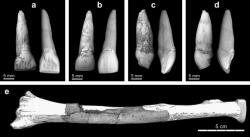Jürgen Richtera, , , Thomas Haucka, Ralf Vogelsanga, Thomas Widlokb, Jean-Marie Le Tensorerc, Peter Schmidd
http://www.sciencedirect.com/science/article/pii/S1040618212002753
Abstract
The African origin of our species has essentially been accepted as a scientific fact, but evolutionary advantages connected with the reasons and circumstances of modern human dispersal remain widely unexplained or controversial. Consequently, this paper provides an overview of the natural and cultural context of earliest AMH (Anatomically Modern Humans). According to the locations and dating of AMH fossils, the focus is on E-Africa, NE-Africa and the Middle East within a time range from 200 ka to 70 ka. At least three different “contextual areas” appear to have existed at the time, two of them in E-Africa and NE-Africa, dominated by “Bifacial-plus-Levallois” technology, and the third one in the Middle East, mostly connected with an “only-Levallois” technology. A comparison with some non-AMH sites from Eurasia displays similarity of technological principles between artifact assemblages from African AMH sites and Eurasian non-AMH (early Neanderthal) sites on the one hand, and dissimilarity between African AMH sites and Middle Eastern AMH sites on the other hand. This is particularly surprising if environmental contexts are taken into account – tropical in Africa and glacial in Eurasia.

Human fossils from Middle Paleolithic levels at Hummal: a–d comparisons of left upper medial incisors (left: hominin from Hummal; right: modern human, a = lingual, b = labial, c = mesial, d = distal); e Fragment of a right radius from Hummal. Hominid remnants from open-air sites are often fragmentary, not allowing for species determination, whereas caves have more often yielded complete skeletons.
Thus, compared to their archaic neighbors (particularly early Neanderthals), earliest modern humans currently seem to lack any specific “cultural fingerprint” and their demographic success may not be explained by behavioral superiority alone. The idea of a small group of early AMH people migrating out of Africa, enabled by cultural superiority over their neighbors appears highly questionable in the light of archaeological evidence. Moreover, the concept of virtual “migration routes” deserves a revision if ethnodemographic evidence about spatial behavior of hunter-gatherers is taken into account. The proposed concept of “contextual areas” serves as a methodological alternative, comprising linked cultural and environmental features.

Spatio-chronological model with two possible events of Homo sapiens sapiens dispersal from Africa, most important fossil finds indicated: Omo, Herto, Singa, Skhul, Qafzeh, Taramsa, Nazlet Khater, Grotta di Cavallo, Kent's Cavern, Oase Cave, Mladec. Y-axis, to the left: time vector; X-axis: spatial vector. Abbreviations and symbols: dotted yellow lines: Mediterranean sapropels S1 to S7, LST: Laacher See Tephra; Y-axis, to the right: temperature variation according to benthic oxygen isotopes (Lisiecki and Raymo, 2009, Fig. 3), Marine isotope stages (MIS) and matching interglacial/glacial cycles.

Spatio-chronological model with two possible events of Homo sapiens sapiens dispersal from Africa, most important fossil finds indicated: Omo, Herto, Singa, Skhul, Qafzeh, Taramsa, Nazlet Khater, Grotta di Cavallo, Kent's Cavern, Oase Cave, Mladec. Y-axis, to the left: time vector; X-axis: spatial vector. Abbreviations and symbols: dotted yellow lines: Mediterranean sapropels S1 to S7, LST: Laacher See Tephra; Y-axis, to the right: temperature variation according to benthic oxygen isotopes (Lisiecki and Raymo, 2009, Fig. 3), Marine isotope stages (MIS) and matching interglacial/glacial cycles.